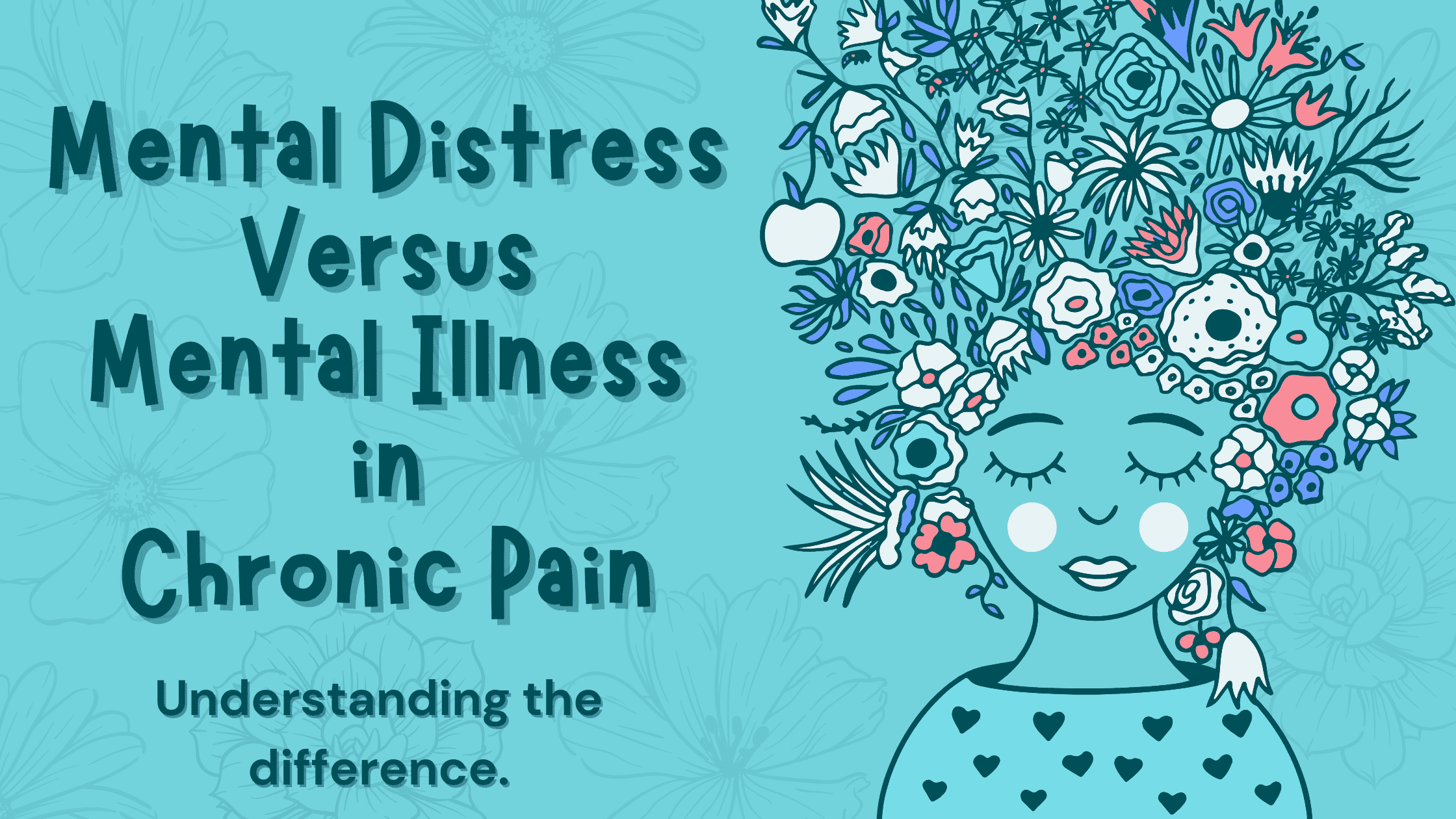In the first few minutes of a recent initial evaluation, my patient burst into tears as she struggled to describe her journey and frustrations with chronic pain. Has this ever happened to you? She reported visiting doctor after doctor in a desperate attempt to obtain a diagnosis. She wanted to get off of the opiate medication prescribed by her primary care physician, but her medication use was regarded with suspicion, disgust, and even pity.
“I’m not crazy! This pain exists!” she said.
Her pain and her distress were real. Unfortunately, she was putting more effort into convincing her physician that she was suffering instead of focusing her energy on behaviors that would improve her health. She described the doctor’s response to her complaints as one of a distressed woman with chronic pain who was addicted to her pain medication. I often find that the more distressed a client is about their chronic pain, the more likely the pain is considered an emotional rather than a physical problem.
The Psychological Component of Pain
Pain is a complex, multifaceted experience that is unique to each individual due to the sensory and affective components it encompasses. The affective component of pain includes emotional, cognitive, and behavioral attributes, creating the “unpleasantness” or suffering that accompanies a painful event [1]. This affective component is crucial, as it exerts significant influence over how the individual interprets their overall well-being in relation to their experience of pain.

Pain has a greater effect on the individual than is typically observed at the surface. Clinicians often make the mistake of taking more of a “clinician centered” approach, focusing treatment sessions and education primarily on pain relief, restoring range of motion, and increasing strength [2]. Granted, these are important aspects of successful treatment and are frequently necessary for patients to return to higher levels of functioning. However, if the focus of therapy relies entirely on these outcomes and fails to not only acknowledge, but take action to address the psychological and social components surrounding pain, outcomes will remain far from optimal.
Until each aspect of the patient’s pain is considered, from anatomic-physiologic to psychological, treatment cannot be considered to truly have a “patient-centered” approach.
While there is education provided to physical therapists regarding the psychological and psychosocial components of pain, these aspects continue to remain too frequently overlooked and undertreated. In fact, when presented with the emotional and behavioral changes resulting from pain, many physical therapists and other healthcare professionals may feel ill-equipped to fully handle this dimension of pain, especially as it spans beyond the traditional anatomic and physiologic knowledge that stands more firmly within the scope of practice. While such education regarding the interplay among emotional, behavioral, and cognitive factors is nowhere near the extent of that provided to mental health professionals, physical therapists do have the ability to incorporate psychological strategies into treatment sessions and interventions in order to help to address the various non-anatomic aspects of pain.
As previously alluded to, the psychological component surrounding pain is very often more limiting than the physical pain itself. Therefore, this overlooked component will rival even the best treatment strategies and interventions. The psychological component typically includes key symptoms, such as decreased motivation and limited self-efficacy, resulting in emotional distress, problem-solving barriers, and difficulty with treatment participation [3]. Patients, particularly those with chronic pain, undergo changes within their social networks, resulting in interpersonal difficulties, isolation, anxiety, and depression. Possible loss of employment and financial challenges due to pain are further stressors that may negatively impact treatment. Therefore, with both acute and chronic pain, it is important to reduce the presence of these emotional and social stressors during therapy in order to maximize treatment [4].
Psychology in Physical Therapy Screening
During initial evaluations, as well as in subsequent treatment sessions, physical therapists are taught to actively screen for “red flags,” or indicators of serious physical pathology or “orange flags,” indicator of serious psychopathology– both warranting a referral for further screening by a physician or psychologist.
In order to address the psychosocial influences surrounding pain, however, therapists must also become aware of “yellow flags,” or thoughts, feelings, or behaviors that may present additional challenges to therapy and may delay recovery. Examples may include evidence of catastrophization, passive coping, fear avoidance, low self-efficacy, and signs of depression, anxiety, or distress [5].
When considering “yellow flags” and negative predictors of recovery, clinicians must also consider where the patient is in their cycle of pain [6]. It is well known that acute injuries respond more favorably to traditional interventions than chronic pain. The cycle of chronic pain can quickly become debilitating. This cycle includes factors such as reduced activity, negative thoughts and beliefs, and prior treatment failures. It also includes physical deterioration from decreased activity, along with feelings of depression and hopelessness. These all combine, resulting in overall suffering and disability. Many of these factors feed into one another, perpetuating the cycle. For example, reduced activity levels may cause the patient to feel depressed, but feelings of depression may, in turn, result in decreased activity levels. This is why treatment must be multidimensional in order to address all components contributing to the generalized disability associated with pain.

Adapted from Nicholas, et al. the “Decade of the Flags” Working Group; Early Identification and Management of Psychological Risk Factors (“Yellow Flags”) in Patients With Low Back Pain: A Reappraisal, Physical Therapy, Volume 91, Issue 5, 1 May 2011, Pages 737–753
Healthcare professionals must also consider that some “yellow flags” may predispose a patient’s episode of pain to becoming more chronic in nature, and therefore more challenging to treat and resolve. For example, fear avoidance beliefs may be perhaps the most important factor in determining the transition from acute to chronic pain, as well as the perpetuation of chronic pain [7]. Such beliefs include feeling that physical activity caused the pain or may make the pain worse, that physical activity is harmful, and that the patient should therefore not participate in physical activities. For acute patients, psychological interventions are increasingly valuable in preventing this acute pain from turning into chronic pain. Therefore, a cycle involving pain-related fear and activity avoidance can lead not only to chronic pain, but disuse, depression, and ultimately, further disability [8].
While having an actual diagnosis may help to reassure some patients, such a medical diagnosis proves to be increasingly detrimental to others. For those already displaying the aforementioned “yellow flags” and who are at a higher risk for chronicity, a medical diagnosis may present as yet another challenge to recovery. Oftentimes having an actual diagnosis gives the patient the message that their pain is a disease that needs careful protection, rather than a common condition [9]. A similar concept holds true for the results of imaging studies, especially as patients often do not understand that findings on imaging do not correlate with pain or symptoms. Diagnoses and imaging, therefore, may be increasingly injurious to a patient’s adjustment and quality of life, primarily when added to existing psychological distress [10]. Therefore, patients may correlate the presence of pain during activity with a continuation of damage, making the patient less physically active and more fear avoidant.
The goal of identifying “yellow flags” is to identify factors that can be positively influenced to facilitate recovery, empower the patient, and to prevent or reduce long-term disability [11]. Additionally, the clinician cannot adequately treat that of which he or she is unaware. It would be unfair to assume that all patients with chronic pain are affected by their pain in the same way and that they would display the same “yellow flags.” Therefore, increased attention to the presence of “yellow flags” can help the clinician to determine which patients would benefit from a more behavioral approach, as opposed to a more traditional, anatomic approach.

Nicholas et al. “Psychologically Informed Interventions for Low Back Pain: An Update for Physical Therapists.” Physical Therapy 91(5): 765-776. May 2011.
In the presence of “yellow flags” and in the absence of “red flags,” patients suffering from chronic pain or who are at risk for chronicity should be encouraged to return to more active lifestyles despite the presence of pain. In fact, clinicians should perhaps aim to tailor their treatments more toward pain management or pain care, as opposed to pain relief, providing education to patients regarding the nature of chronic pain. Emphasis should be placed upon the concept that it is possible AND desirable to resume normal activities despite the persistence of pain.
How can clinicians encourage a patient demonstrating “yellow flags” to stay active despite continued pain associated with movement?
In such cases, reassurance alone proves to hold little benefit [12]. These patients have a significant fear of movement and further injury, so much so, that they have selectively limited their performance at home, work, recreation and in society in order to avoid discomfort. For these patients, simply stating that “exercise will not hurt you” appears comparable to reassurance that touching a hot stove will not result in injury. While clinicians understand the physical and psychological benefits exercise can bring to a patient experiencing chronic pain, the individual often cannot see past these activities that they have deemed to be unsafe. Perhaps they have experienced an injury in the past resulting in pain and dysfunction, or perhaps their presence of pain during movement convinces them that further injury is occurring. Clinicians must instead address the patient’s specific concerns and apprehensions as opposed to providing general encouragement and then focusing on the physical components of the exam [13].
It would be unfair to assume that all patients with chronic pain are affected by their pain in the same way. Click To Tweet
Unfortunately, for many fear-avoidant patients, education is typically not enough to encourage activity, especially when activity results in constant, or even potential pain. Instead, activity-based approaches in which interventions are focused on maximizing function and maximizing activity are necessary. The two most commonly used approaches include graded exercise and graded exposure.
Graded Exercise and Graded Exposure
Graded exercise and graded exposure both involve the patient first identifying activities they are fearful of performing due to their pain. The physical therapist then works directly with the patient to set realistic goals and expectations for treatment [14]. This is an important step, especially when treatment is focused more toward pain management and maximization of function, as opposed to the elimination of pain. This helps to establish clear communication, as well as build trust within the patient-clinician relationship. Additionally, increased control is valuable for the patient who may be feeling out of control with their pain and its result on their lives. By giving the patient the lead role in treatment sessions, with the physical therapist serving as a guide and a coach, the patient can begin to tackle their challenges and increase self-efficacy.
The treatment plans for both graded exercise and graded exposure then incorporate the feared activity or activities into treatment sessions. However, during graded exercise, the patient is encouraged to perform the feared activity or movement under direct supervision of a movement professional, with hopes that confidence gained during the session can begin to translate into increased activity levels at home. The home program then takes the form of behavioral goal quotas [15]. Here dosage follows a quota system in which an initial therapeutic quota is set and gradually increased across sessions. The patient must maintain a given level of activity or must perform certain activities at home. Here, pain is not used to determine exercise or activity level in an effort to begin to direct the patient away from their focus on pain. Additionally, allowing pain levels to limit activity would only further the concept that activity may be causing further damage and that pain levels reaching a given point may be indicative of possible damage. Therefore, the goal is to reach the set quota despite the presence of pain. If the quota is not met, the therapist does not offer reinforcement, but instead discusses the importance of continuing activity with the patient, helps to problem solve barriers to adherence, and works to develop a plan for dealing with obstacles. Reward is internalized, with the patient building up confidence and being able to better increase their level of functioning.
For patients with higher levels of fear, graded exposure may instead be necessary to serve as the behavioral treatment of choice [16, 17]. While graded exercise focuses more on completing the full activity, graded exposure breaks down the activity into multiple, smaller movements in order to first minimize fear. This strategy also helps to increase morale and self-efficacy, as it allows the patient to have smaller “wins” during each session, which ultimately culminate in the patient performing the full activity. Here, exercise is not progressed until fear subsides at each stage. Graded exposure is reserved only for patients who have very clear signs of fear toward movement and fear of reinjury. For patients only demonstrating decreased activity, such an approach is not beneficial, as it may instead instill the idea that the patient should be more fearful toward physical activity or that they must limit activity in order to avoid injury. The home program for those utilizing graded exposure is similar to that of graded exercise, except the physical therapist is sending these smaller, graded exercises and movements home with increased monitoring on the patient’s ability to carry through with this exercise in a functional setting.
When used appropriately, both methods work to demonstrate that it is possible to increase activity and return to activities of daily living, work, and social events even in the presence of pain. Ideally, the patient is being shown that when not focusing on the presence of pain, they are able to be more active and decrease their perceived, and perhaps self-induced limitations. Importantly, these techniques work to turn avoiders into confronters and to provide the message that relief depends upon individual effort and persistence.
Cognitive Restructuring through Mindfulness
Graded exercise and graded exposure can be considered to be two forms of cognitive restructuring. These methods work to gradually change the patient’s attitude toward physical activity and strive to put them in the “driver’s seat” of their own success. Through increased control, as well as increased self-efficacy, the patient is able to be more active and can better participate in work, school, and social life, which can positively impact any remaining psychosocial factors.
Graded exercise and graded exposure can be considered to be two forms of cognitive restructuring. Click To Tweet
All psychological and psychosocial treatments relate back to the individual’s mindset. If expectations are consistently negative and motivation toward recovery is minimal, outcomes will naturally be negligible. Similarly, if the patient continues to return their focus only to the presence of pain, therapy sessions will remain self-limiting and unproductive.
This is where mindfulness and meditation come into the forefront. There is abundant evidence favoring the implementation of mindfulness meditation for the use of pain regulation and in some cases, pain relief. While this can take many forms, the common theme behind mindfulness meditation in cases of acute, and especially chronic pain, is to draw focus away from the painful stimulus and away from the emotions and thoughts that accompany it. Mindfulness can help attenuate the overall experience of pain by impacting the expectation of pain, the attention toward the painful stimuli, and the overall emotional and psychological response toward the pain [18]. In fact, mindfulness meditation training has been shown to have positive results in patients with chronic low back pain, fibromyalgia, and irritable bowel syndrome. Even after 8 weeks of training, these patients saw significant improvements in pain symptoms and as well as in overall quality of life [19, 20, 21]. These improvements were shown to be lasting, provided the individual was able to utilize the mindfulness techniques taught on an ongoing and daily basis. Interestingly enough, implementing mindfulness meditation resulted in a cascade of gradual changes within the brain that altered how the individual processed pain, allowing them to move from a state of decreased focus on a painful sensation to a state of enhanced emotional control.
Key Points for Physical Therapists
The key to success in addressing the psychological aspects of pain can be accomplished with a cognitive-behavioral analysis and screening, the collaboration towards a change plan with the patient, and the implementation of such a plan with guidance from the physical therapist.
When working with any patient, but especially those suffering from ongoing pain, it is important to empower the patient during the overall course of treatment. While addressing anatomic limitations is important, patients demonstrating “yellow flags” or signs indicating a higher predisposition toward chronicity need these sessions to be especially meaningful in order to increase carry-over when not in the clinic.
Addressing all aspects of the experience of pain can better break the cycle of suffering and disability that the episode of pain has created. Patients need to hold a key role in goal setting and must be able to understand their own successes during treatment. In turn, this helps to address self-doubt, feelings of helplessness, and fear of movement. Ultimately, physical therapists are collaborating with the patient to increase self-management of their pain, to reduce pain-related disability, and to subsequently reduce emotional and social related distresses. Physical therapists can help patients feel a greater sense of control over their pain and can enable them to return to a more normal life, despite the presence of pain. This is only achieved through the integration both physical and psychological components of pain care.



